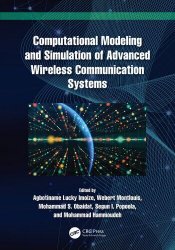 Название
Название: Computational Modeling and Simulation of Advanced Wireless Communication Systems
Автор: Agbotiname Lucky Imoize, Webert Montlouis, Mohammad S. Obaidat, Segun I. Popoola
Издательство: CRC Press
Год: 2025
Страниц: 469
Язык: английский
Формат: pdf (true)
Размер: 47.2 MB
The book covers the exploitation of computational models for effectively developing and managing large-scale wireless communication systems. The goal is to create and establish computational models for seamless human interaction and efficient decision-making in beyond 5G wireless systems.
Computational Modeling and Simulation of Advanced Wireless Communication Systems looks to create and establish computational models for seamless human interaction and efficient decision-making in the beyond 5G wireless systems. This book presents the design and development of several computational modeling techniques and their applications in wireless communication systems. It examines shortcomings and limitations of the existing computational models and offers solutions to revamp the traditional architecture toward addressing the vast network issues in wireless systems. The book addresses the need to design efficient computational and simulation models to address several issues in wireless communication systems, such as interference, pathloss, delay, traffic outage, and so forth. It discusses how theoretical, mathematical, and experimental results are integrated for optimal system performance to enhance the quality of service for mobile subscribers.
Further, the book is intended for industry and academic researchers, scientists, and engineers in the fields of wireless communications and ICTs. It is structured to present a practical guide to wireless communication engineers, IT practitioners, researchers, students, and other professionals.
The book is well structured into sixteen chapters outlined as follows:
Chapter 1 presents an overview of computational modeling and simulations in wireless communication systems. The chapter elucidates the fundamental concepts and significance of computational modeling and simulations in this context and emphasizes how simulations can help to unravel the complexities inherent in wireless communication systems, providing insights into system behavior, facilitating efficient performance evaluation, and optimizing designs. Through effective network planning, protocol development, and performance analysis, computational modeling and simulations, the reliability and efficiency of wireless networks can be significantly enhanced.
Chapter 2 explores the historical perspectives on computational modeling and simulation in wireless communication systems. The chapter calls for the development of more sophisticated analytical approaches for designing and optimizing networks as systems complexity increases. The authors emphasized that tracing this intertwined history offers insights into the foundations of cutting-edge solutions to the proliferating issues in wireless communication systems. Additionally, the work explores pivotal development across fundamental science, transitional shifts, recent algorithms, and practical use cases spanning early quantitative inquiries in electromagnetism to increasingly versatile software abstractions stretched to their limits in 5G wireless networks and beyond.
Chapter 3 focuses on computational modeling of communication systems and networks. In particular, the work explores the potential application of Federated Learning (FL) and Machine Learning (ML) in addressing computational modeling issues in emerging wireless networks. FL is currently attracting attention as an integral machine-learning technique to shift the computing load to edge devices. The chapter investigates FL in small-cell networks, where users and many base stations (BSs) are dispersed following a uniform Poisson point process (PPP) with different densities.
Chapter 4 presents computational modeling and analysis of wireless sensor networks. The findings from the study reflect that Wireless Sensor Networks (WSNs) have experienced increasing complexity due to the wide range of civil and military applications they serve...
Скачать Computational Modeling and Simulation of Advanced Wireless Communication Systems
[related-news]
[/related-news]